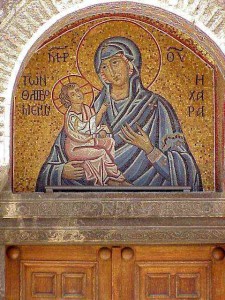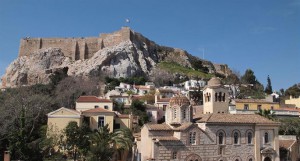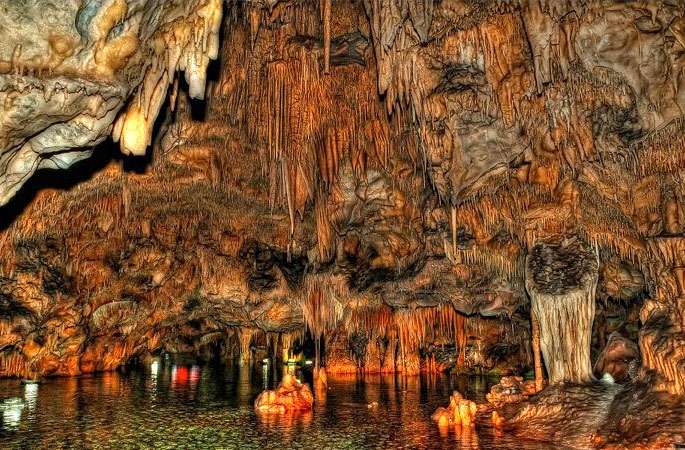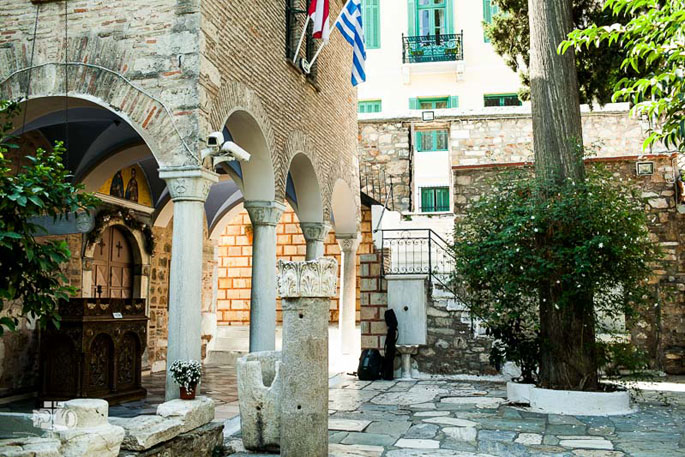 In a large seaside area that extends from Agia Marina and Agios Nikolaos to the Voies plain and Elafonisos, lies a rare natural phenomenon, the only one of its kind throughout Europe. It is of a rich geological museum of petrified tree trunks that date back to two or three million years. Among the finds are rare shell, algae and other sea creature fossils that complete the unique collection. The coasts of Agios Nikolaos, Agia Marina, Spitha and Voies represent the most interesting part of the forest. In Korakas village, visitors can admire the forest’s tallest two meter tree trunk, named “human” by the locals. The trail to the forest begins from the little church of Saint Marina. Voies municipality has created a modern geopark, with walking routes and informational material, around the Petrified Forest, in Agios Nikolaos region. Petrified forests are protected natural monuments of great scientific value.
In a large seaside area that extends from Agia Marina and Agios Nikolaos to the Voies plain and Elafonisos, lies a rare natural phenomenon, the only one of its kind throughout Europe. It is of a rich geological museum of petrified tree trunks that date back to two or three million years. Among the finds are rare shell, algae and other sea creature fossils that complete the unique collection. The coasts of Agios Nikolaos, Agia Marina, Spitha and Voies represent the most interesting part of the forest. In Korakas village, visitors can admire the forest’s tallest two meter tree trunk, named “human” by the locals. The trail to the forest begins from the little church of Saint Marina. Voies municipality has created a modern geopark, with walking routes and informational material, around the Petrified Forest, in Agios Nikolaos region. Petrified forests are protected natural monuments of great scientific value.
The Petrified Forest is a valuable geological museum and a miracle for the land of Laconia. It extends along the coast of Agios Nikolaos in Neapoli. Fossils of tree trunks with petrified roots that date back to two or three million years ago were discovered next to the sea. Palm trees, conifers, and hardwood trunks (0.50cm to 1m diameter) were petrified due to various natural phenomena and they were recalcifiered by the rise of the sea level. The findings, unique in Europe, are priceless for scientific study. The creation of petrified trunks followed the procedure of the main petrification, namely the replacement of the organic material, molecule after molecule, by dissolved minerals rich in calcite and pyrite; the morphological characteristics of the trees were conserved in very good condition.
 The findings lie in a large coastal surface that extends from Agia Marina to Cape Maleas and reaches the Voies plain and Elafonisos. The most interesting part lies in the three rocky beaches of Agia Marina, to the east of Korakas and at Spitha beach in Agios Nikolaos. At Korakas you will find the “human”, the forest’s tallest two meter tree trunk. Numerous rare sea fossils can be observed at the coast and the surrounding fields; starfishes, snails, shells, crabs, mussels and various other shellfishes. It is very easy to cross the forest. You can start from the trail in the village of Agios Nikolaos and take the path that passes from the left side of Agia Marina church. Voies municipality has created a modern geopark, with walking routes around the Petrified Forest and information material.
The findings lie in a large coastal surface that extends from Agia Marina to Cape Maleas and reaches the Voies plain and Elafonisos. The most interesting part lies in the three rocky beaches of Agia Marina, to the east of Korakas and at Spitha beach in Agios Nikolaos. At Korakas you will find the “human”, the forest’s tallest two meter tree trunk. Numerous rare sea fossils can be observed at the coast and the surrounding fields; starfishes, snails, shells, crabs, mussels and various other shellfishes. It is very easy to cross the forest. You can start from the trail in the village of Agios Nikolaos and take the path that passes from the left side of Agia Marina church. Voies municipality has created a modern geopark, with walking routes around the Petrified Forest and information material.
Source: www.mythicalpeloponnese.gr
 Just south of Aeropolis, at Diros bay, is the Glyfada cave (or Vlychada cave). It offers visitors a spectacular beauty hidden in the depths of the earth. It is a sea cave of exquisite beauty that is considered to be the best from the three most beautiful sea caves in the world. It is a tour sight and is 3.100 meters in length. Visitors can go through dry and wet areas with a plethora of arcades and chambers. Moreover it possesses a sensational, colorful mineral decor of compelling column shaped stalactites and stalagmites. The tour follows a circular route and the wet area, 2.800 meters in length, takes place solely by boat. The cave exploration started in 1949 and today over 10.000 m2 have been explored. The Glyfada Cave at Diros is currently considered the largest and most famous sea cave of the country.
Just south of Aeropolis, at Diros bay, is the Glyfada cave (or Vlychada cave). It offers visitors a spectacular beauty hidden in the depths of the earth. It is a sea cave of exquisite beauty that is considered to be the best from the three most beautiful sea caves in the world. It is a tour sight and is 3.100 meters in length. Visitors can go through dry and wet areas with a plethora of arcades and chambers. Moreover it possesses a sensational, colorful mineral decor of compelling column shaped stalactites and stalagmites. The tour follows a circular route and the wet area, 2.800 meters in length, takes place solely by boat. The cave exploration started in 1949 and today over 10.000 m2 have been explored. The Glyfada Cave at Diros is currently considered the largest and most famous sea cave of the country.
 Also known as Vlychada, the Glyfada cave is located on the west coast of the Laconic Peninsula, at Diros bay. The cave consists of a subterranean river that runs through the cave and empties into the sea 23 meters to the right side of the cave’s entrance that is half a meter tall from water level. It is the first cave of this specific area and the best from the three most beautiful sea caves in the world. It possesses a sensational, colorful mineral decor of compelling column shaped gray and white stalactites and stalagmites. It consists of dry and wet areas with a plethora of arcades and chambers, the majority of which is covered in sea water. It is the largest and most well-known cave of the country. It is 3.100 meters in length with only 300 of these being dry. For tour purposes, two new entrances were opened in addition to the existing one. The tour follows a circular route and lasts 45 minutes and the wet areas are solely toured by boat. The cave has a stable temperature of 18⁰ C. The water level fluctuates depending on the outdoor weather conditions, with a maximum water depth of 15.5 meters and a temperature of 12⁰ C. Below the entrance of the cave is Diros bay, with its whitewashed pebbles and crystal clear waters.
Also known as Vlychada, the Glyfada cave is located on the west coast of the Laconic Peninsula, at Diros bay. The cave consists of a subterranean river that runs through the cave and empties into the sea 23 meters to the right side of the cave’s entrance that is half a meter tall from water level. It is the first cave of this specific area and the best from the three most beautiful sea caves in the world. It possesses a sensational, colorful mineral decor of compelling column shaped gray and white stalactites and stalagmites. It consists of dry and wet areas with a plethora of arcades and chambers, the majority of which is covered in sea water. It is the largest and most well-known cave of the country. It is 3.100 meters in length with only 300 of these being dry. For tour purposes, two new entrances were opened in addition to the existing one. The tour follows a circular route and lasts 45 minutes and the wet areas are solely toured by boat. The cave has a stable temperature of 18⁰ C. The water level fluctuates depending on the outdoor weather conditions, with a maximum water depth of 15.5 meters and a temperature of 12⁰ C. Below the entrance of the cave is Diros bay, with its whitewashed pebbles and crystal clear waters.
The cave was discovered by Petros Arapakis and its exploration started in 1949 by Ioannis and Anna Petrocheilou. Bones of prehistoric oxen, hippopotamus, hyenas and of other animals as well as ceramic utensils of the prehistoric times were found in the cave. Today over 10.000 m2 have been explored. Due to its natural marine entrance, the cave was not use by humans.
Source: www.mythicalpeloponnese.gr
The European Protection, Management and Moderate Tourist Development program set up a climbing sports park in the Lagada region, of mount Taygetus. It contains more than 50 routes developed in four levels and move on slates.
All the routes are sufficiently equipped with 10mm stainless stoppers.The return is possible through rappel. The routes are meant for experienced climbers.
Τhe area is located a few kilometers after the settlement of Trypi. Mid-May until mid-October are considered the period for climbing.
Information: Hellenic Climbing Association of Sparti, Gortsoglou 97, 231 00 Sparti, tel/fax: 27310 22574
Source: www.mythicalpeloponnese.gr
Three days festival dedicated to the laconic olive oil and the edible olive, takes places every August in Sellasia of the Municipality of Sparta. In this festival various producers with their own pavilions take part, but also production firms of the prefecture in order to highlight and promote the laconic olive oil.
 The exhibition is organized by the Municipality of Sparta and the non-profit organization “Olive and Olive Oil Festival”. It includes various cultural events, like tributes, product tasting and folk music. There are also conferences, speeches and conventions about agricultural and rural development, the organic agriculture, the production, the market, the history, the use and the quality characteristics of the olive, the olive oil and the other laconic products.
The exhibition is organized by the Municipality of Sparta and the non-profit organization “Olive and Olive Oil Festival”. It includes various cultural events, like tributes, product tasting and folk music. There are also conferences, speeches and conventions about agricultural and rural development, the organic agriculture, the production, the market, the history, the use and the quality characteristics of the olive, the olive oil and the other laconic products.
The festival is organized under the auspices of the Ministry of Production, Rural Development, Industry and the Environmentand the Province of Peloponnese.
Source: www.mythicalpeloponnese.gr
 The Turkish bath of the Aerides is located on Kyrristou street in Plaka. Built during the years of the Ottoman occupation, the “Ibn Efendi Turkish Bath” was open to the public. Extensively damaged during the siege of the Acropolis by Kioutahi Pasha in 1827, it was later repaired and modernized by King Otto. Following World War II, the bath continued operations until 1960, when it was abandoned.
The Turkish bath of the Aerides is located on Kyrristou street in Plaka. Built during the years of the Ottoman occupation, the “Ibn Efendi Turkish Bath” was open to the public. Extensively damaged during the siege of the Acropolis by Kioutahi Pasha in 1827, it was later repaired and modernized by King Otto. Following World War II, the bath continued operations until 1960, when it was abandoned.
 During the 1980’s and the 1990’s, the Ministry of Civilization performed several interventions and restructuring work, in order to restore the building and turn it into an exhibition venue. Today, visitors can see how a Turkish bath operated during the time of the Ottoman occupation, as well as subsequent eras. The building also houses an annex of the Museum of Hellenic Folk Art.
During the 1980’s and the 1990’s, the Ministry of Civilization performed several interventions and restructuring work, in order to restore the building and turn it into an exhibition venue. Today, visitors can see how a Turkish bath operated during the time of the Ottoman occupation, as well as subsequent eras. The building also houses an annex of the Museum of Hellenic Folk Art.
Source: www.athensattica.gr
Excavations carried out during the previous century, north of the modern town of Sparta, brought to light an impressive construction. The edifice that dates back to the 5th century B.C. was made from large limestone. Waldstein, who carried out the excavations in 1892, initially thought it was a small temple. Although its use is not yet verified, it is believed to be the tomb of Leonidas. According to Pausanias, it was here that the remains of the legendary king of Sparta were transferred and buried after the battle in Thermopylae. The tomb of Leonidas is the only preserved monument of the Ancient Agora.
 The tomb of Leonidas, north to the modern town of Sparta, is an emblem and an important monument, as it is the only monument preserved from the Ancient Agora. Also known and as Leonidaion, excavations of the construction were carried out by Waldstein in 1892. The impressive edifice (12.5 × 8.30 m) has the form of a temple probably dating back to the late 5th century B.C.. It was made of massive limestone and its interior was divided in two connected chambers. The eastern chamber was 3.15 meters long, had the form of a vestibule and was ornate with columns.
The tomb of Leonidas, north to the modern town of Sparta, is an emblem and an important monument, as it is the only monument preserved from the Ancient Agora. Also known and as Leonidaion, excavations of the construction were carried out by Waldstein in 1892. The impressive edifice (12.5 × 8.30 m) has the form of a temple probably dating back to the late 5th century B.C.. It was made of massive limestone and its interior was divided in two connected chambers. The eastern chamber was 3.15 meters long, had the form of a vestibule and was ornate with columns.
Until today, it is not known what the edifice was used for. It is believed to be a cenotaph, while many researchers share the opinion that it is the temple of Karneio Apollo. Although there is no indication on the correlation between the temple and the legendary king of Sparta, according to local tradition and the travel writer Pausanias, the remains of Leonidas were transferred and buried there. It is because of this, that the locals believe it to be the tomb of Leonidas. According to Pausanias the tomb was situated to the west of the Agora, opposite to the theater, and hosted games once a year.
Source: www.mythicalpeloponnese.gr
 The byzantine church of Kapnikarea is one of the major landmarks of Athens’ Byzantine past. Dating from the 11th century, it is dedicated to the “Presentation of the Virgin to the Temple,” and lies in the middle of Ermou street. It is believed that the church was built over an older, Christian temple, commissioned in the 5th Century A.C. by the Athenian Empress of Byzantine, Eudokia, wife of Emperor Theodosius the Younger. Constructed atop the foundations of the ancient temple of Athena or, perhaps, Demeter, it is today owned by the University of Athens.
The byzantine church of Kapnikarea is one of the major landmarks of Athens’ Byzantine past. Dating from the 11th century, it is dedicated to the “Presentation of the Virgin to the Temple,” and lies in the middle of Ermou street. It is believed that the church was built over an older, Christian temple, commissioned in the 5th Century A.C. by the Athenian Empress of Byzantine, Eudokia, wife of Emperor Theodosius the Younger. Constructed atop the foundations of the ancient temple of Athena or, perhaps, Demeter, it is today owned by the University of Athens.
Constructed as a domed, cross-in-square complex, the three sections of the church were built at separate times; In the early 20th Century, the chapel of St. Barbara was added to the northern section of the church. Many of the interior murals were painted by famed artist, Fotis Kondoglou. The temple owes its name to its first owner who, according to tradition, collected the “Tobacco Tax” (kapnikos foros) in the city. Yet another tradition is connected to the church’s older name, “Kamouharea,” the famous silk cloth workshops (kamouhades) that operated in the area.
Source: www.athensattica.gr
 Kleanthi-Schaubert, or the “Old University,” is on Tholou street in one of the higher sections of Plaka. Built around the 17th Century, the institution was purchased from its Ottoman owner by two close friends, architects Kleanthis and Schaubert, who, after arriving in the newly liberated Athens, went to work on the old building, repairing and restoring its huge walls and domed basements, adding other buildings, and uniting them all into a single complex. In 1834 the building housed the Girls High School and, later, the newly founded University.
Kleanthi-Schaubert, or the “Old University,” is on Tholou street in one of the higher sections of Plaka. Built around the 17th Century, the institution was purchased from its Ottoman owner by two close friends, architects Kleanthis and Schaubert, who, after arriving in the newly liberated Athens, went to work on the old building, repairing and restoring its huge walls and domed basements, adding other buildings, and uniting them all into a single complex. In 1834 the building housed the Girls High School and, later, the newly founded University.
Then, in 1837, three new rooms and an Anatomy auditorium were added to cover the needs of the new University. When the University finally moved into its own building after 1841, the original Kleanthi Residence became the Didaskaleion and the Experimental InterTeaching School, which was later used as a barracks. The facility changed hands many times over the years, and was used for various purposes until 1963 when it was declared a listed building. In 1967 it was officially assigned to the University. Since then it has been restored, and now houses the University’s History Museum.
Source: www.athensattica.gr
The 17th century Church of Agioi Anargyroi, also known as the Metochion of the Holy Sepulchre, is located at the Anafiotika, in Plaka. Originally opened as a convent, presumed to have been owned by the prominent Kolokinthi family.
 The church is a single-clite basilica, dedicated to the Ag. Anargyroi. Due to its function as an embassy church of the Holy Sepulchre since the 18th century, the Metochion is deeply involved with the holy ceremonies of Easter. Designated as the point of initial reception of the Holy Light from the Sepulchre in Jerusalem, on the night of celebration of the Holy Resurrection, the church attracts many visitors. It was built on the site of an ancient temple dedicated to goddess Aphrodite.
The church is a single-clite basilica, dedicated to the Ag. Anargyroi. Due to its function as an embassy church of the Holy Sepulchre since the 18th century, the Metochion is deeply involved with the holy ceremonies of Easter. Designated as the point of initial reception of the Holy Light from the Sepulchre in Jerusalem, on the night of celebration of the Holy Resurrection, the church attracts many visitors. It was built on the site of an ancient temple dedicated to goddess Aphrodite.
Source: www.athensattica.gr
 The church of Agios Nikolaos Ragavas is located in Plaka, close to the Anafiotika neighborhood. Built in the 11th century, it is one of the major monuments from that era. Based on the simple four-aisled, cross-in-square design, the church is topped with a small octagonal dome of the Athenian era. Originally belonging to a Byzantine family named Ragavis.
The church of Agios Nikolaos Ragavas is located in Plaka, close to the Anafiotika neighborhood. Built in the 11th century, it is one of the major monuments from that era. Based on the simple four-aisled, cross-in-square design, the church is topped with a small octagonal dome of the Athenian era. Originally belonging to a Byzantine family named Ragavis.
The church became derelict during the Revolution of 1821, but was eventually rebuilt using the original materials. Since then, it has undergone numerous modifications, which have significantly altered its appearance. During the 1970’s it was partially restored to its original condition, but not completely. Tradition has it that this church’s bell was the first one to ring out following the liberation of Athens from German occupation on October 12, 1944.
Source: www.athensattica.gr

































